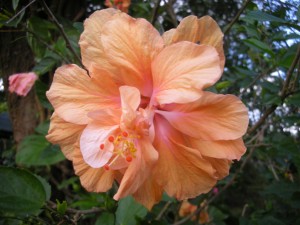 Tagatay City, in the Luzon province of Cavite, is famous for its breath-taking ridge views of Lake Taal and the volcano in its centre. It is one of the country’s favorite destinations for locals and expatriates alike. In November, members of the British Women’s Association were invited on a full day tour along the lesser known roads of Cavite: a magical mystery tour that took us far from the madding crowd, in a four-car convoy.
Tagatay City, in the Luzon province of Cavite, is famous for its breath-taking ridge views of Lake Taal and the volcano in its centre. It is one of the country’s favorite destinations for locals and expatriates alike. In November, members of the British Women’s Association were invited on a full day tour along the lesser known roads of Cavite: a magical mystery tour that took us far from the madding crowd, in a four-car convoy.
The Cornerstone Pottery Farm in Silang
We took a rather circuitous route to the Pottery farm that eventually came to an end at the top of a muddy farm track, where thick jungle seemed in danger of closing in on us. Here we met EJ, who happily gave us a tour of his rustic factory.
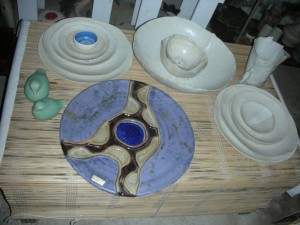 Adorned in large, ungainly heaps of unglazed pots and mugs, bowls and teapots, the factory itself is a simple, spacious, open wicker shed. Three large modern kilns stand squarely in the centre, and can apparently reach temperatures of over 1000’C. Someone suggested they could also be used for roasting pork – but only if you like your lechon incinerated!
Adorned in large, ungainly heaps of unglazed pots and mugs, bowls and teapots, the factory itself is a simple, spacious, open wicker shed. Three large modern kilns stand squarely in the centre, and can apparently reach temperatures of over 1000’C. Someone suggested they could also be used for roasting pork – but only if you like your lechon incinerated!
Two smaller sheds display the finished products, which include many beautiful one-off pieces as well as an array of more practical products, such as chunky coffee mugs, candle holders and wind chimes.
EJ set up the business when he returned from the States in 1996. Pottery is his passion, but he also wanted to do something for the community. Until recently he employed four people part-time to cater to the tourist trade, but recently, thanks to Fair Trade and a deal with a European retail company, he has been able to train four new staff and provide full-time employment for them all.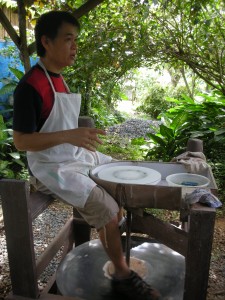
Before we left, EJ mounted the old-fashioned manual potter’s wheel in the garden in order to demonstrate how to throw a pot. His description of balancing the clay after he had thrown it, to stop it “dancing” on the wheel, was positively poetic. We all admired his skills at turning the wheel with his foot while creating a lovely fluted bowl with his hands. It was quite hypnotic to watch, and EJ told us that it can also be a very therapeutic activity for the potter!
The Ilog Maria Bee Farm
Our next destination involved another narrow farm track, on which we were at constant risk of losing our wing mirrors to the encroaching hedgerow. The Bee Farm is apparently renowned as the best apiary in Luzon and even has a cult following. A number of small white hives announced our arrival, lining up along the middle of the field like a guard of honour.
The Bee Farm grows imported Italian bees from which the bee keepers harvest honey, beeswax, pollen, royal jelly and bee venom. 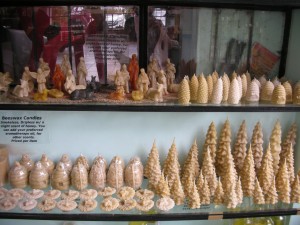 Honey is not only very nutritious, they told us, it also has medicinal and healing properties, it is good for stress relief and it builds up resistance to disease. Applied immediately, it is even good for burns. You name it, it seems honey can cure it… even acne! Thus, in a small shop at the front of the farm, there is a wide selection of honey-based soaps, honey cider vinegar and honey for sale, as well as a honey throat spray, honey hand sanitizer, and a honey ointment for beestings. Beeswax had been used to make candles in all shapes and sizes – there was even a beeswax Nativity. Behind the show room we found a CR (Comfort Room or toilet) in the shape of a beehive. Built in the round, this novelty ‘throne room’ was decorated with hanging baskets, the ‘throne’ mounted on a low dais in the centre. A truly unique experience!
Honey is not only very nutritious, they told us, it also has medicinal and healing properties, it is good for stress relief and it builds up resistance to disease. Applied immediately, it is even good for burns. You name it, it seems honey can cure it… even acne! Thus, in a small shop at the front of the farm, there is a wide selection of honey-based soaps, honey cider vinegar and honey for sale, as well as a honey throat spray, honey hand sanitizer, and a honey ointment for beestings. Beeswax had been used to make candles in all shapes and sizes – there was even a beeswax Nativity. Behind the show room we found a CR (Comfort Room or toilet) in the shape of a beehive. Built in the round, this novelty ‘throne room’ was decorated with hanging baskets, the ‘throne’ mounted on a low dais in the centre. A truly unique experience!
Bawai’s Vietnamese Kitchen
By now every stomach was grumbling. So it was with hungry enthusiasm that we headed off to find lunch. Bawai’s Vietnamese Kitchen is actually situated in the home of the cook, Yong Tatlonghari. Bawai is Vietnamese for granny, as Yong was born in Vietnam, but settled in the Philippines after marrying her Filipino husband, Virgilio. This small, home-grown restaurant is tucked away down yet another country lane: Hernandez Street, Purok 5, Bucal, Silang. It is truly a hidden treasure. BVK is cash payment only and is normally open only on Fridays and weekends (it may be safer to make a reservation well in advance), but we made a special mid-week group booking and were warmly welcomed.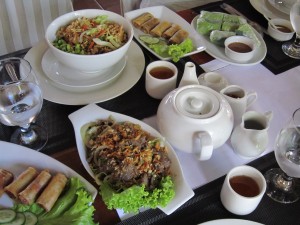
On a tight schedule, our efficient guide had wisely taken our orders earlier in the week, and it wasn’t long before we were grazing happily on a banquet of fresh and fried spring rolls, a delicious watercress and seared beef salad (goi rau muong), noodle soups, grilled pork rib with Vietnamese omelet (com suon cha), and spicy tamarind prawns (tom rang me). Yong says she only uses fresh and authentic ingredients imported from Vietnam. Seated on the top floor of their country house, overlooking a coconut grove, it was like coming home for dinner, and the meal was exceptional.
The Flower Farm
From Tagaytay City, the Flower Farm can be found in Barangay Guinhawa, a short 10-minute drive from the Aguinaldo Highway.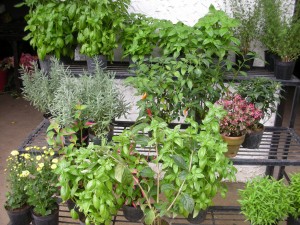
Begun as a hobby twenty five years ago, the Flower Farm now covers seven hectares of hillside, where black netting ‘green-houses’ cover quarter acre blocks full of chrysanthemums and gerbera, anthuriums, lavender, chillis and herbs. Several of us commented on the joys of wandering through this park-like farm – the trees, the grass, the fresh air – and decided it was the perfect spot for a Devonshire cream tea and a picnic rug. Many of us took a little piece of this Eden home with us in the shape of pots of lavender, basil, mint or red chillis.
Yoki Farm
Our final stop was a hydroponic lettuce farm. Here the lettuces are grown in nutrient-filled water that is transported to the plants in lengths of PVC piping. Hydroponic gardening is far less labour intensive than traditional soil-based gardening and it also allows for multiple harvests each year as it relies less on the weather. They grow several varieties of lettuce there and some herbs as well, providing this produce for a number of local restaurants.
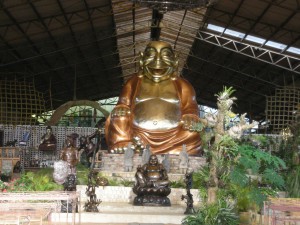 The owner is also an obsessive collector of – well – anything! A giant laughing Buddha greeted us as we wandered down the drive: shiny, gold and ENORMOUS. Apparently it is good luck to be photographed with this vast personage, but I personally found him daunting and kept my distance. He was waited on by at least a dozen miniature versions of himself in yoga poses at his feet. Behind these Holy relics is a vast warehouse overflowed with bronze statues, Singer sewing machines and billiard tables (we counted more than twenty) on which is displayed, amongst other things, 3 large jade galleons floating on a sea of deodorant balls. I am not kidding. Broken gym equipment, vases, chandeliers, exotic birds… the list goes on and on. I was sure that somewhere there I would find the mountain of odd socks and biros that disappear down worm holes in everyone’s house. It provided an eccentric and amusing finale to our brief escape from the confines of Metro Manila.
The owner is also an obsessive collector of – well – anything! A giant laughing Buddha greeted us as we wandered down the drive: shiny, gold and ENORMOUS. Apparently it is good luck to be photographed with this vast personage, but I personally found him daunting and kept my distance. He was waited on by at least a dozen miniature versions of himself in yoga poses at his feet. Behind these Holy relics is a vast warehouse overflowed with bronze statues, Singer sewing machines and billiard tables (we counted more than twenty) on which is displayed, amongst other things, 3 large jade galleons floating on a sea of deodorant balls. I am not kidding. Broken gym equipment, vases, chandeliers, exotic birds… the list goes on and on. I was sure that somewhere there I would find the mountain of odd socks and biros that disappear down worm holes in everyone’s house. It provided an eccentric and amusing finale to our brief escape from the confines of Metro Manila.

Admiring the time and effort you put into your website and detailed information you provide. It’s good to come across a blog every once in a while that isn’t the same old rehashed inaimrftoon. Wonderful read! I’ve saved your site and I’m adding your RSS feeds to my Google account.